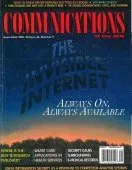September 2001 - Vol. 44 No. 9

Features
This magazine has chronicled the Internet and all its evolutionary turns since its earliest days in 1969. Over the years we’ve tracked its basic technology (and all the branches it spawned), evaluated its business, cultural, and educational potential, assessed its effect on global commerce, argued its societal efficacy, interpreted its growth patterns, and warned of […]
Studies and new research show employees who telecommute believe the arrangements actually hurt family life and career advancement. In fact, a number of supervisors are revoking these arrangements due to telecommuting-related problems, reports USA Today. Telecommuting hasn’t grown at the clip many experts first predicted in the 1970s; there were 21 million workers in 1997 […]
In the Introduction to the special section "The Global IT Work Force," (July 2001, p. 31), guest editors Arnold and Niederman make the following statement: "Work in industry can be so lucrative and intellectually rewarding, that many faculty are leaving academia, thus rendering it increasingly difficult to provide development of the next generation of IT […]
Practical Programmer: Of Model Changeovers, Style, and Fatware
Creating an excuse for the consumer to buy something "new."
Staying Connected: Suit Yourself
As lawsuits increase, the mobile phone industry still won't admit its most important need—more research.
Viewpoint: What to Know Before Reissuing Old Titles as E-Books
Do grants of rights to "print, publish, and sell" a literary work "in book form" cover the new digital medium?
A look back from the future will marvel at the numbers and variety of communicating, interacting devices and services instantly available anywhere, anytime an IP node is near.
Inspired by terrestrial packet switching, NASA is standardizing the protocols needed for intelligent communication with and among spacecraft scattered around the solar system, as well as with robots sent to explore other planets.
The Internet's ultimate utility depends on our ability and willingness to make the network at least as pervasive, convenient, and invisible as electricity is today.
An Asturian View of Networking 2015
Build, share, and use the Internet to avoid the risk of your language, history, customs, literature, and laws being left out and forgotten.
Web site growth and popularity actually follow rules that can be explained mathematically and are useful for predicting the Web's future behavior.
Whatever Happened to the Next-Generation Internet?
Despite its performance benefits, long history of development, and well-heeled advocates, IPv6 may never replace IPv4.
Using Information Security as a Response to Competitor Analysis Systems
To protect your firm's valuable business data from competitors, sometimes it's best to think like competitors and take a walk in their shoes.
A Web-Enabled Framework For Smart Card Applications in Health Services
Your complete medical history and vital medical records stored on a device the size and shape of a credit card. The technology's been around for awhile, but its portability involves more than size.
Matching Records in a National Medical Patient Index
Examining the benefits and pitfalls of a distributed collection of medical records.
Security Issues For Implementation of E-Medical Records
Effective administration of a medical database requires balancing technical and nontechnical managerial challenges.
Thinking Objectively: an Introduction to Software Stability
Studying the design and development that produces stable (or unstable) software.
Inside Risks: Web Cookies: Not Just a Privacy Risk
Most people have heard about the risks of Web cookies in the context of user privacy. Advertisers such as DoubleClick use cookies to track users and deliver targeted advertising, drawing significant media attention (see Hal Berghel’s "Caustic Cookies, Communications, May 2001). But cookies are also used to authenticate users to personalized services, which is at […]



